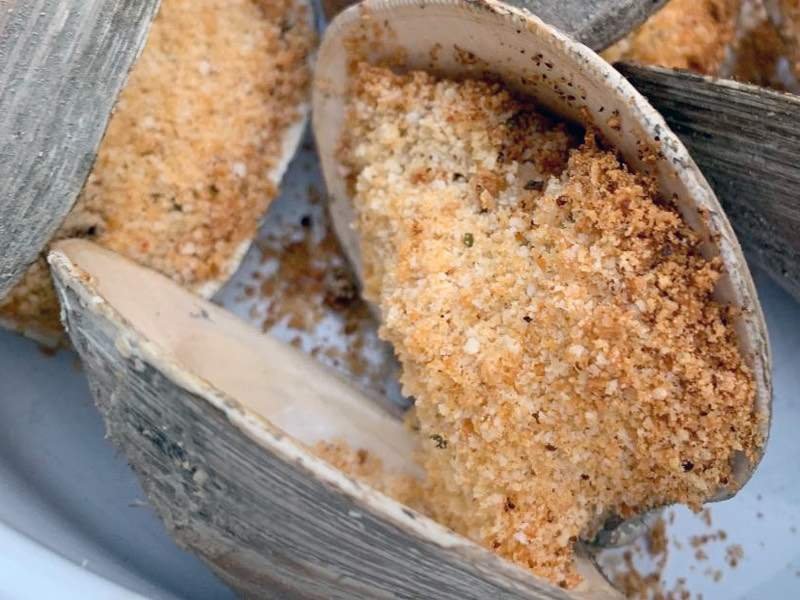Your Essential Guide to Clams

Fresh clams are one of the most versatile seafood, whether enjoyed in the classic dish of linguine with clams or clams fried to crispy, golden perfection as a summertime treat. Robert DiGregorgio, Head of Quality Control at FultonFishMarket.com, walks us through the different types of clams and how to best enjoy one of America's favorite shellfish.
History of Clams
The enjoyment of clams was an early passion predating America and even the European exploration of North America. The Algonquin word for clams, “poquauhok”, eventually morphed into “quahog”, a now common term for hard clams. So common were clams in the New World that in 1641 the New Netherland Colony (the first Dutch colony in North America) passed an ordinance stating that polished clam shells, strung as beads or belts and used by the local tribes as wampum (money), would also serve as money in the colony.
Skip ahead 331 years.
Types of Clams
We get a lot of questions about clams, mainly what are the differences between the types of fresh clams. Hard clams - littleneck, topneck, cherrystones and chowder clams - are found all along the eastern seaboard, from Canada to Florida. They are all the same species of clam, just different sizes. There are no official regulations pertaining to how big a clam has to be to be a littleneck or a cherrystone or a topneck. The State is only concerned that you don’t harvest clams that are too small, and in New York that means less than 1-inch at the hinge.
Clam Sizes
- Littleneck Clams: 1 ½” - 2” wide
- Topneck Clams: 2 - 3” wide
- Cherrystone Clams: 3 - 4”
- Chowder Clams: 4”+
Littleneck clams are the smallest and sweetest available, great raw on the half shell or steamed. Topneck clams can also be eaten raw, and these are my favorite size for baked clams. Cherrystone clams are usually not eaten raw, they’re not tough really, just too much of a mouthful for most people. You can slice up cherrystones for soups, chowders, clam sauce and stuffing. Finally, chowder clams. Definitely not for the raw bar. They are great though, as the name implies, for chowders.
Clams are very slow growers - it may take 2 to 3 years for a clam to reach littleneck size, and a large chowder clam can easily be 30 or 40 years old.
Clams reproduce when the water warms up, late spring and early summer typically. They use a method similar to trees and flowers called broadcast spawning. Just as trees and flowers broadcast their pollen into the air, so do clams, broadcasting their seed into the water, putting their trust in sheer numbers and the currents.
Like all American fisheries, the clam industry is closely watched and highly regulated. The New York State Department of Environmental Conservation oversees the business along with local town and county administrators. They require permits, licenses, logs and paperwork. They are constantly checking water values, and when they see fit, according to their guidelines, will close an area to clamming. Usually just briefly due to an algae bloom or run-off from heavy rains.
To show you just how serious the industry is, administrators will check the size of the clams as well as records indicating where they are from. They are very serious and very professional, and in a very serious and very professional manner they will fine you and confiscate your clams. First time, you’ll probably get a warning. They will explain what you’re doing wrong and how to correct it. They will show up for a review sometime later to make sure everything is by the book. You can expect fines if you don’t have your paperwork straight by then. If you’re a habitual offender - digging in closed areas, your clams are too small, paperwork never right, you can expect to have your permits revoked and even be jailed...yes, jail!
They have to be strict about these things because clams harvested from closed areas can make a lot of people ill. Fish can swim away from dirty water and from algae, but shellfish are pretty stationary. They’re stuck there. The New York State DEC are very proactive about this, and we can all thank them for their diligence. At FultonFishMarket.com I am proud to say we can tell you not only the state from where the clams were harvested, but the exact area of water, the date they were dug, the size of the clam, how many clams were sent that day from that location to us, the digger’s number, the date they were shipped, when we received them, temperature, and much more. Complete transparency.
What are Chopped Clams?
Also called surf clams or skimmers, they are found all along the East Coast from Maine to North Carolina, out to Georges Bank, with New Jersey being the largest producer. Never heard of these? You’ve probably eaten them, though. They make up 70% of all clams harvested in the U.S. and are the largest commercial clam industry by far. These clams are huge - their shells are 6” to 9” across, and they weigh 2-3 pounds at optimal harvest size but grow even larger. Their shells look like salad plates, and sometimes as a kid, we’d find these on the beach, especially after a storm, and take them home for ashtrays or for dishes to keep loose change in. I say you’ve probably eaten them because they are used commercially in soups and sauces, bottled as clam juice, used in chowders, stuffed clams, and sold as fried clam strips.
Fun fact: Back in the 1950s, the Howard Johnson chain made fried clam strips a menu staple and introduced them to millions from coast to coast.
The surf clam industry was the first to have a management plan and is currently managed by NOAA Fisheries, the Mid-Atlantic Fishery Management Council, the Surf Clam - Ocean Quahog Fishery Management Plan as well as various state resource management agencies. They regulate the permits, quotas, minimum size limit, vessel monitoring as well as other aspects of the fishery. It is considered a very healthy fishery.
What are Razor Clams?
Unlike some clams, razor clams are easy to identify, with their long thin narrow shell. They look like a straight razor or a folded jackknife (no wonder it’s also known as the Atlantic Jackknife Clam). These clams are found all along the East Coast from Canada to South Carolina, but until recently, they were easier to find on a beach than in a New York City restaurant. Nowadays, though, more and more chefs are seeking unique, local ingredients, and the razor clam has come into its own and is garnering its share of the limelight. Home cooks, no longer intimidated by this unusual clam, aren’t afraid to try some in their kitchens as well.
Razor clams have large, creamy-colored meat. While they are not typically eaten raw, they are very versatile, and there are countless ways to enjoy them. They are delicious as fritters or steamed. They are excellent in ceviche, pan-fried, roasted in the oven, in chowders, or as an ingredient in a seafood salad.
The one thing about these clams, though, is that they must be harvested by hand. Their shells are very thin and very brittle. The clammers look for a little dimple in the wet sand at low tide, but you just can’t start digging with a rake because the shells are so delicate. And you can’t try to dig them out by hand because they can dig down faster than you can dig them up! So the clammers have a trick. They pour a little salt or inject a very salty solution into the burrow, and in a few seconds the clam will pop out of the hole where it is plucked out of the sand.
What are Manila Clams?
Also known as Japanese littlenecks, manila clams were originally found in Asia and the Indian Ocean. Legend says they were unintentionally exported to the U.S. by Japan in some oyster seed in the 1920s. They have now spread all along the West Coast from British Columbia to Northern California. They are extremely adaptable, tolerate a wide range of salinity and temperature, and in warmer temperatures, can spawn all year round. These traits have made them extremely successful, and they have spread from Asia to North America to Hawaii to Western Europe, Israel, North Africa, seemingly everywhere.
Manila clams are sweet, plump, and tender with ridged shells of different colors and patterns and are very attractive on the plate. They’re preferred at the smaller sizes, usually 1 ½” to 2 ½” across.
Manila clams can be eaten raw, but I prefer them steamed with garlic and wine, grilled with lemon and butter, or in clam sauce over linguine.
What are Soft Clams?
Soft clams are also known as steamer clams, Ipswich clams or belly clams. Fried soft clams, according to legend, were started in 1916 by a potato chip producer in Boston who one day had access to more soft clams than potatoes. He had vats of oil, very few potatoes, and piles and piles of soft clams. He decided to experiment, and a New England specialty was born.
They are found mainly from Maine to Long Island, and years ago, the harvest was so heavy in Ipswich, Massachusetts, that they became known as Ipswich clams. Now however, partly due to an invasion of little green crabs who have decided soft clams are their favorite thing to eat, as well as other factors, the harvest is less than half of what it once was. Not to worry, though. Maine, Long Island, and other parts of Cape Cod still have wonderful soft clams. And like many local foods, every town in Massachusetts, Maine, and parts of Long Island (where I used to dig buckets of these) think they have the best soft clams.
Soft clams are generally oval in shape, never tightly closed, and their siphons protrude to varying degrees. Like razor clams, their shells are very brittle, very thin and easily broken. When you walk on the flats at low tide, they will jet a little stream of water in the air. I’m not sure if it’s to dissuade predators or from the pressure above as you walk near them, but either way, to me, it means “dig here!” Luckily they don’t dig as fast as razor clams and can be dug up, carefully, with a hand rake.
Like oysters, bay scallops and other shellfish, their taste is greatly influenced by their environment. Water temperature, salinity, nutrients in the water and whether the clams are in mud or sand all influence their taste. Soft clams are famously steamed, the skin removed easily with your fingers, dipped in the seasoned broth they were steamed in, then dipped in butter. Another great way to enjoy them is fried, either as a sandwich with some good tartare sauce and lettuce, or as a fried plate with salad. With their different textures and flavors all in one package, these clams are truly distinctive, unique, luscious and delicious.
"My brothers were long time bay men, commercial diggers on the Great South Bay. I was just out of the service and getting antsy, so they said come work on the boat a few days, make some money.
Now, the only clam digging I ever did was as a kid with my feet, but these guys were serious! Theirs was a tong boat, inboard, flat and wide. The tongs were 12 feet long, and they seemed to get longer as the day wore on. Picture a giant pair of ice tongs; you held the poles apart, opening the claw like baskets on the bottom. Then, you shoved them down into the sand or mud, wriggled them deeper into the bottom, then closed your hands, closing the baskets. Then you shimmied them up on deck, opened them again dumping their contents.
Again and again and again. Over and over. Even for a young guy just out of the Marines this was hard work! The clams were separated by size, bagged, tagged and sold to buyers waiting for us at the dock. Necks, a combination of littlenecks and topnecks were worth the most, then cherrystones, then chowder clams.
It’s pretty much the same today, but with a little more fine tuning as to the sizes. These days you’ll commonly see - smallest to largest - littlenecks, middlenecks, topnecks, cherrystones, and chowder clams. More people prefer the smaller clams for various reasons, and so the prices adjust accordingly. It’s all based on demand, really."
Our Favorite Clam Recipes
Linguine with clams is the ultimate in comfort food. Briny, sweet clams tossed with pasta plus a little heat from red pepper flakes and garlic, it’s a restaurant favorite for good reason. Our classic recipe comes together in 15 minutes!
Perfect Grilled Stuffed Clams Recipe
We love stuffed clams, and we love grilled clams. What happens if you combine the two? Grilled stuffed clams are a little smoky, a little briny, and a lot of delicious. This might just be our new favorite way to eat clams.
Ditch the delivery and make these easy clam pizzas at home. Sweet, briny clams make the perfect topping along with garlic, herbs and cheese.



